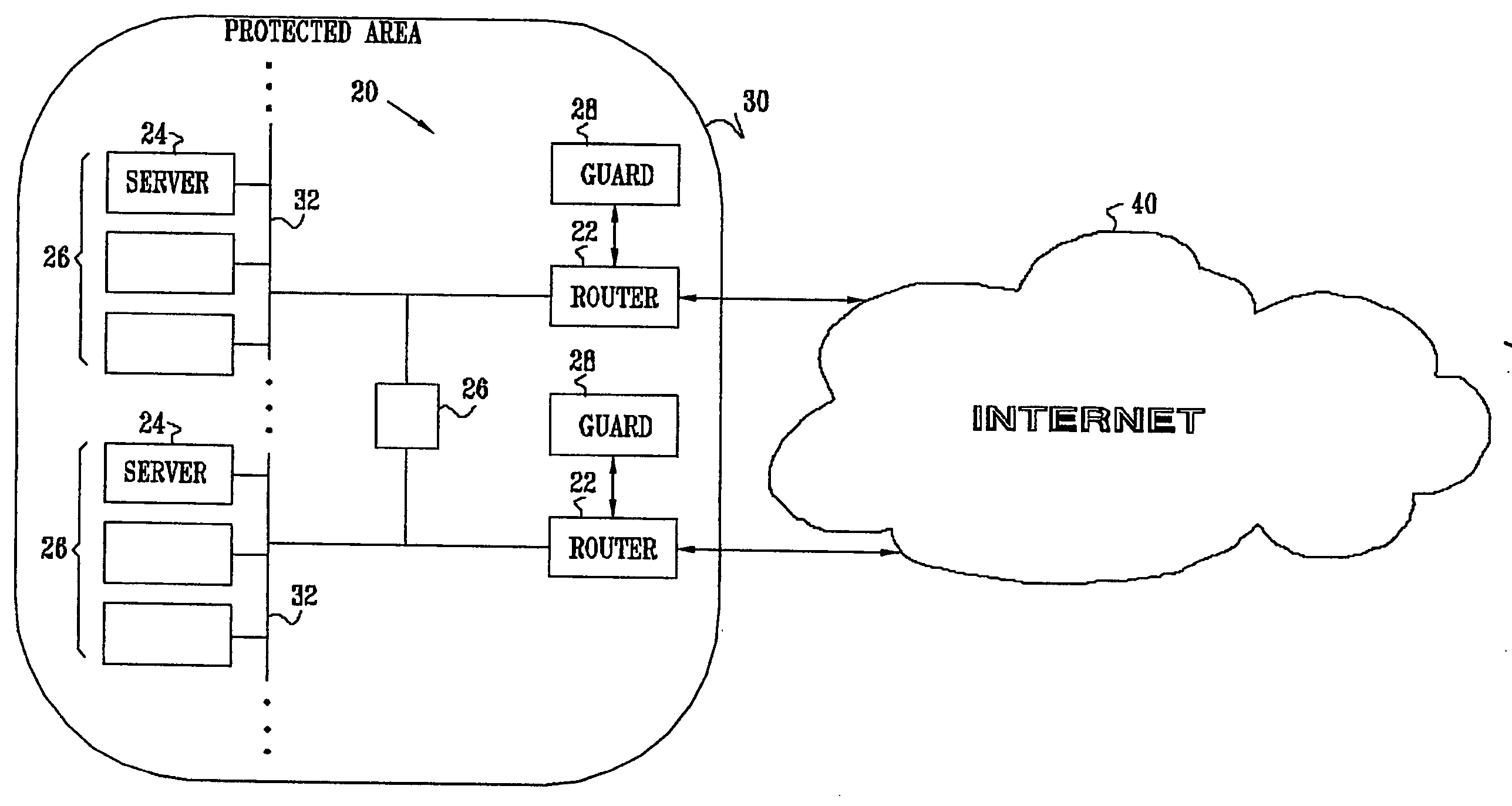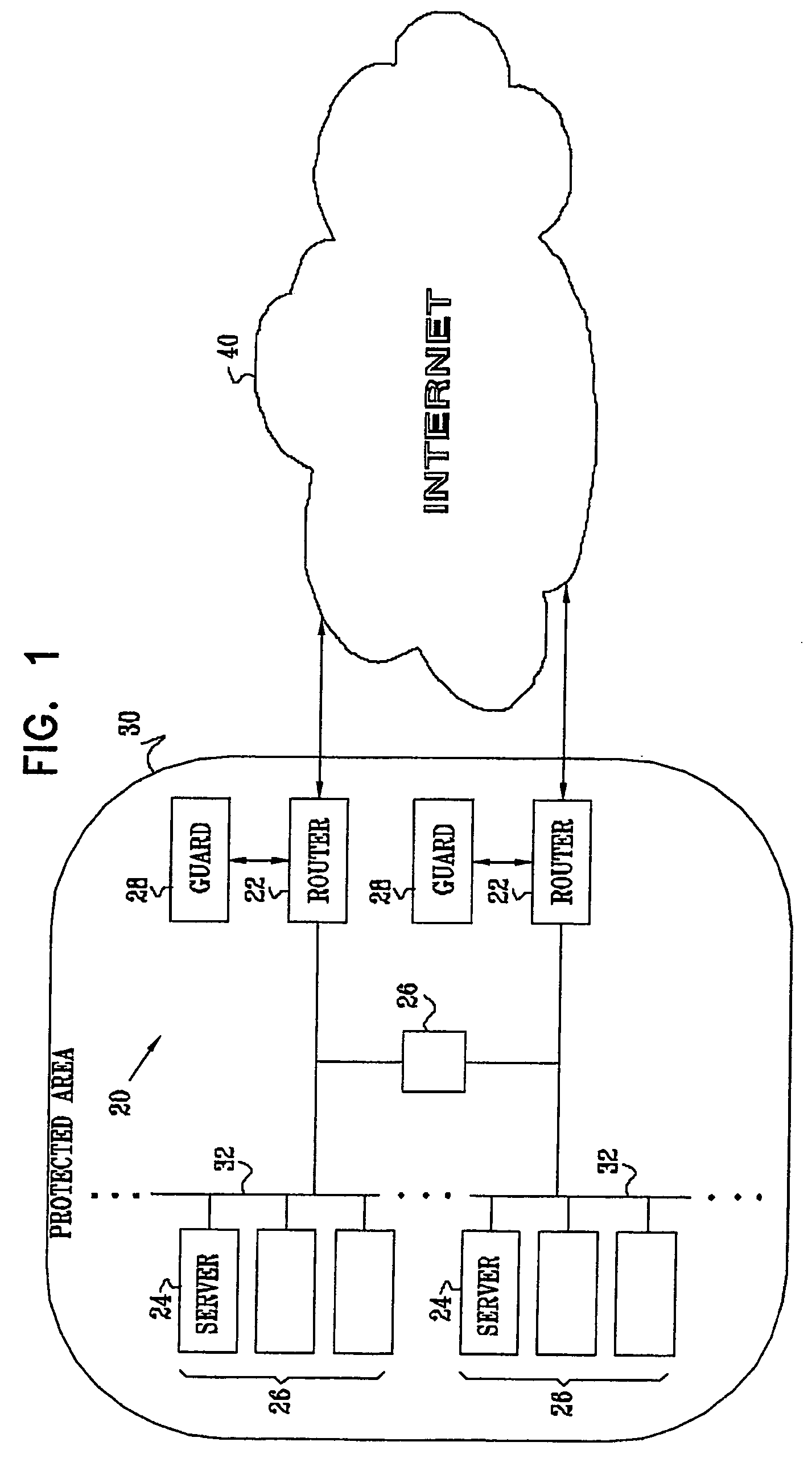[0007] For some applications, the network guard
system monitors incoming packets, in order to prevent a malicious source from establishing connections with servers within a
protected area of a network. In some such embodiments of the present invention, a network protected with the network guard
system designates a set of network addresses (such as IP addresses) assigned to the network as “trap” addresses. These trap addresses are assigned to one or more guard devices, but otherwise are not used by other elements of the network. When a packet addressed to such a trap address enters the protected network, the packet is forwarded to the assigned guard device, which analyzes the traffic. The guard device may determine that the traffic from a given source address is suspicious, based on the content or statistical properties of the traffic, for example. The guard device may then block or otherwise filter incoming traffic from the suspicious source address, to reduce the likelihood of servers within the
protected area of a network becoming infected with a worm. Alternatively or additionally, the guard device may then begin monitoring all packets entering the
protected area of the network. These techniques for protecting against incoming worm-generated traffic can reduce bandwidth consumption between the protected network and a wide-
area network, such as
the Internet. For example, these techniques may reduce outgoing traffic generated by elements in the protected area in response to the incoming traffic, such as SYN-ACK responses generated by internal servers when attempting to establish a
handshake with infected external servers.
[0008] Alternatively or additionally, the network guard
system monitors outgoing packets originating from servers in a protected area. Typically, the guard system detects an infected
server by determining that the
server is attempting to create a large number of connections to different addresses within a short time, or to create a connection with a non-existing address. By detecting and blocking infected outgoing packets, the guard system prevents servers infected with a worm from establishing specific types of connections with servers outside the protected area. This technique can also reduce bandwidth consumption between the protected network and a wide-
area network, such as the Internet, (a) by reducing outbound traffic generated by servers infected with a worm, both when the servers attempt to propagate the worm and when they participate in a DDoS attack, and (b) by reducing inbound traffic generated in response to the malicious outbound traffic, such as SYN-ACK responses generated by external servers when attempting to establish a
handshake with infected internal servers. Additionally, upon detecting an infected
server, the guard system typically generates a
network administrator alert, so that the administrator can take appropriate action, such as cleaning infected servers.
[0038] in response to receiving the packet, initiating diversion of further data packets sent over the network from sources outside a protected area of the network, so as to prevent malicious traffic from reaching the protected area of the network.
[0048] There is still further provided, in accordance with an embodiment of the present invention, apparatus for analyzing packet-based communication traffic, including a guard device, which is adapted to designate one or more network addresses as trap addresses, to receive a data packet sent over the network to one of the trap addresses, and, in response to receiving the packet, to initiate diversion of further data packets sent over the network from sources outside a protected area of the network, so as to prevent malicious traffic from reaching the protected area of the network.
[0053] There is still further provided, in accordance with an embodiment of the present invention, a
computer software product for analyzing packet-based communication traffic, the product including a computer-readable medium in which program instructions are stored, which instructions, when read by a computer, cause the computer to designate one or more network addresses as trap addresses, to receive a data packet sent over the network to one of the trap addresses, and, in response to receiving the packet, to initiate diversion of further data packets sent over the network from sources outside a protected area of the network, so as to prevent malicious traffic from reaching the protected area of the network.
 Login to View More
Login to View More  Login to View More
Login to View More 


